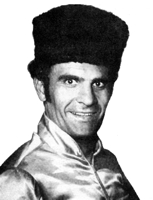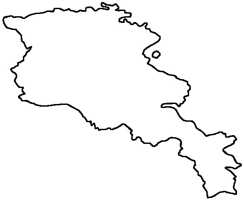
|
The Society of Folk Dance Historians (SFDH)
Armenia and the Armenians
[
Home |
About |
Encyclopedia | CLICK AN IMAGE TO ENLARGE |

|
 The Armenians are decendants of a branch of the Indo-Europeans and described by the Ancient Greek historian Herodotus as being related to the Phrygians, who entered Asia Minor from Thrace. The various ancient peoples, mainly Urartians, who originally inhabited what is generally referred to as the Armenian Plateau, one of the world's oldest centers of civilization (today, eastern Turkey, the southern Caucasus, and extending partly into Iran, Iraq, and Syria) were gradually destroyed during the Fifth and Sixth Centuries BCE under the blows, among others, of Sycthian, Assyrian, and Median armies. The Armenians established themselves and founded their new state. They call themselves Hayk and their country Hayastin, the roots of which are derived from the legendary patriarch of the Armenians – Hayk.
The Armenians are decendants of a branch of the Indo-Europeans and described by the Ancient Greek historian Herodotus as being related to the Phrygians, who entered Asia Minor from Thrace. The various ancient peoples, mainly Urartians, who originally inhabited what is generally referred to as the Armenian Plateau, one of the world's oldest centers of civilization (today, eastern Turkey, the southern Caucasus, and extending partly into Iran, Iraq, and Syria) were gradually destroyed during the Fifth and Sixth Centuries BCE under the blows, among others, of Sycthian, Assyrian, and Median armies. The Armenians established themselves and founded their new state. They call themselves Hayk and their country Hayastin, the roots of which are derived from the legendary patriarch of the Armenians – Hayk.
The Armenian language is a member of the Indo-Armenian Apostolic Church. There are small percentages of Catholics and Protestants. Armenia was the world's first Christian state, accepting Christianity in 301 CE. The Armenian alphabet was created by Mesrob Mashtots in the early Fifth Century BCE. The Greek was, in part, an influence.
Modern-day Soviet Armenia is part of ancient Armenia. Occupying a landlocked area just south of the geat mountain range of the Caucasus, between the Caspian and Black Seas, Armenia is the smallest of the fifteen replublics making up the Soviet Union which it joined in 1920. It is the home of almost three million people of which Armenians constitute over nibnety percent. Minorities cosist mainly of Russians, Turks, and Kurds. The Republic is extremely mountainous with an area of over 11,500 square miles. It is a land of extinct volcanoes chopped by ridges, deep gorges, and valleys. It's average altitude is 5,900 feet above sea level. Because of its deep inland position, the climate is extremely varied. Armenia is not generously endowed by nature but irrigation, especially in the lower altitudes, has brought about a rich abundance of various fruits and vegegtables. The high elevations are extremely rich in minerals.
Historically, Armenia was consistently subjugated through wars by surrounding major powers of which the Persians, Byzantines, Arabs, and Turks are the most important to list. However, the Armenians developed territorial leadership through dynasties and principalities. Each invasion or conquest of Armenia and each migration into the land has left not only a genetic and biological imprint but also a linguistic, cultural, and religious stamp on the people of the region. The result appears to be as brought out in their songs and dances. Contributions to the world by Armenians in the files of literature, architecture, art, music, medicine, and science are vast.
At the end of the Fifteenth Century the invasion of Armenia by Ottoman Turks began. Several centuries of wars between the Ottomans and others all but crippled the Armenian people. Turkey dominated Armenia into the latter part of the Nineteenth Century. Religious, economical, historical, and political differences created hardships for the Armenian nation. Inspired by other members of the Ottoman Empire winning their independence, revolutionary activity among the Armenians developed. Unfortunately, their dreams for an independent Armenia were met with death and massacre at the hands of the Ottoman Turks. From the latter Nineteenth Century to 1915, almost two million Armenians lost their lives. The result of these killings was a dispersion by the hundreds of thousands in every direction – north to Russia, east to Asia, south to the Arab countries, and west to Europe and the Americas.
From the Idyllwild Folk Dance Workshop 1984 syllabus.
DOCUMENTS
- Armenia, a country.
- Armenian Dance, an article.
- Armenian Dances, an article.
- Armenian Dancing, an article.
- Armenian Folk Dance Types, an article
- Armenian History and Culture, an article.
- Peoples of the North Caucasus, an article
- Tom Bozigian, an article.
- Transcaucasia, a region.
This page © 2018 by Ron Houston.
Please do not copy any part of this page without including this copyright notice.
Please do not copy small portions out of context.
Please do not copy large portions without permission from Ron Houston.